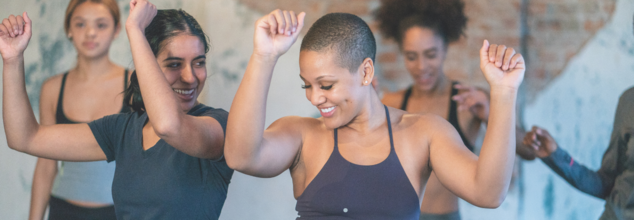- Health Conditions A-Z
- Health & Wellness
- Nutrition
- Fitness
- Health News
- Ayurveda
- Videos
- Medicine A-Z
- Parenting
- Web Stories
International Dance Day: How Can Dance Benefit Your Mental Health?

Credits: Canva
As we today observe the World Dance Day, let us look at what dancing can help us with. Of course, the physical benefits are there. When you move your body, do any sort of physical activities, you are working out in some form and it helps you stay fit. Like everyone have their fitness regime, your dance routine can also help you stay fit. In fact there are certain fitness regime, including Zumba that keeps you fit through dance.
However, the benefits go much beyond just physical fitness, dancing can actually help you live a stress free life.
TikTok Dances For Mental Health
In one of the latest trends in TikTok, people are bringing back pangs of nostalgia to the internet with their 90s dance on rapper Doechii's song 'Anxiety' from the "The Fresh Prince of Bel Air".
Why is this trend important? With big names also jumping in and dancing to the rhythms, including Wil Smith and Tatyana Ali, experts say that this is helping ordinary people normalize anxiety.
Certain anxiety disorders are marked by persistent, or excessive worry. It could be fear about situations. As per the Mayo Clinic, these moments of anxiety can include panic attacks and sudden episodes of intense fear or discomfort
Research suggest that creative activities, including dancing can help relieve this stress. Dancing also engages multiple areas of the brain and demands full attention, which can then shift the focus from anxiety feelings. Supporting this idea, a 2021 study from UCLA Health found that conscious dance led to mental health improvements in a large majority of participants, particularly those dealing with anxiety, depression, or a history of trauma.
Dancing: A Complete Stress Buster
Dance involves full-body movement and coordination. This kind of physical activity stimulates the release of endorphins—natural chemicals in the brain that act as mood boosters and stress relievers. During a panic attack, when anxiety can feel overwhelming, these endorphins help calm the body and mind.
Engaging in dance also activates deep breathing patterns, especially in structured styles like Indian classical dance. This is important because panic attacks often lead to rapid, shallow breathing or hyperventilation. The breath control involved in dancing can help slow things down and regulate the body’s response.
In addition, dance improves body awareness. When someone is in the middle of a panic attack, they often feel disconnected or dissociated from reality. Focusing on movement—on the placement of your arms, the rhythm of your steps, the tension in your muscles—can bring attention back to the present. This grounding effect helps reduce the intensity of the attack and prevents it from escalating.
Dance as a Distraction and a Mindfulness Tool
Experts explain that one reason dance can be so effective is because it serves as a powerful distraction. Instead of spiraling into anxious thoughts, the brain is forced to concentrate on movement, rhythm, and coordination. This temporary shift in focus can prevent panic from taking over.
Dance also builds mindfulness, a practice often recommended in therapy. Whether it's through a slow classical routine or a high-energy freestyle session, dance requires attention to the now. The combination of mental focus and physical release gives the body a chance to reset and relax.
Why Do I Keep Having Stressful Dreams About School? What Do These Recurring Dreams Mean?

It's a simple Monday morning, the sun’s up bright and early, the weather is pleasant, but the anxiety strikes me as soon as I open my eyes. It's the dreaded 10th grade Math exam, the one subject I never excelled at. As if it wasn’t enough that the exam could make or break whether I get enough overall grade to get into my dream schools, if I were to get a bad score on this, it would be a permanent mark on my record.
“I had studied enough, I can do this” I told myself, but what was the point my admit card was nowhere to be found. I searched high and low, my anxiety peaking with every passing minute. “I thought I got up in time? Why am I late, they’ll never let me into the exam hall” I could hear my heartbeat in my ears and it’s getting louder, louder and louder, until it's just a loud long noise. Next thing I know, I’m on my bed, I graduated 10th grade years ago and this was a dream.
What Do Stressful Dreams About School Say About You?
If it isn’t your school exam, then maybe your college entrance exam or perhaps a qualifying exam that could determine whether you get your dream job or not. Recurring dreams about school happen to a lot of us.
These dreams are very common. Experts suggest that they often appear when a person is feeling anxious in their waking life, especially about being evaluated or judged by a boss or another authority figure. These dreams can take many forms: a person might oversleep for an exam, be unable to find their classroom, study the wrong subject, or even show up to school without clothes. The dreams revisit a place where we first experienced success or failure based on our performance.
To understand this, one must know that dreams are a way for the mind to process memories and experiences, both conscious and unconscious. The school setting in these dreams is a stand-in for a feeling of being tested in life and worrying about not meeting other people’s expectations.
Why School is the Go-To Setting
The reason school so often appears as the setting for these anxiety dreams is because it’s where we first learn how to deal with life. Feelings of stress, inadequacy, and embarrassment often happen first in a school environment. These early experiences create foundational beliefs in our unconscious mind about how we handle pressure. For some people, these beliefs can be very hard to change, causing feelings of stress and worry to resurface years later in dreams, even if the beliefs aren't relevant to their adult life.
What Do Recurring Dreams Reveal About Us?
According to the Sleep Foundation, having a recurring dream—the same dream happening again and again—is a sign of an unresolved problem or a difficult emotion in a person’s life. These dreams may be a way for the mind to make sense of past experiences, or they might be a sort of practice run to help a person prepare for a threat or challenge they're facing in real life. The dreams are often a way for the mind to push a person to finally face and deal with a problem.
Another reason for a recurring dream is that it represents a basic psychological need that isn't being met. Experts say everyone needs to feel independent, feel capable, and feel connected to others. Some research has found that people who lack these feelings are more likely to have recurring nightmares with negative themes, such as failing, falling, or being attacked.
Can You Stop Recurring Dreams?
If you're bothered by having the same dream over and over, you can take some steps to try and make them stop. Experts recommend a few different approaches
- Address the root problem. If you can figure out what emotional problems or difficult feelings are causing your dreams, working through them may help the dreams stop.
- Consider therapy. A specific type of therapy called imagery rehearsal therapy is often recommended. With a therapist's guidance, you can practice reimagining the dream with a more positive ending.
- Reduce stress. Since negative recurring dreams are often linked to stress, finding ways to lower your stress levels may also help reduce the dreams.
- Prioritize mental health. People with mental health conditions like depression often have more negative recurring dreams. Treating these conditions can help reduce the frequency of bad dreams.
- Adopt healthy sleep habits. To get a better night's sleep, try to go to bed and wake up at the same time every day. It’s also a good idea to avoid caffeine, alcohol, nicotine, and fatty foods close to bedtime.
- Talk to your doctor about your medications. Some medications, including melatonin, can cause nightmares. Your doctor can advise you on whether changing the dose or stopping the medication might help.
- Treat sleep disorders. If you have a condition like insomnia or sleep apnea, getting treatment for it could help reduce how often you have negative recurring dreams.
Diagnostic Anomaly: Rare Condition Makes This Teen Remembers Everything: She Has Access To Memories That Many Others Don't

At least once in our lives, most of us have dreamed of having a perfect memory. A brain that would remember crucial details at the nick of time, whether it is during your exam or an interview. But this is not just a dream, it is just another day for this young girl, who has a ‘Super Brain’.
Scientifically speaking, she has a very rare condition that makes her remember every detail of her life, like a record. In a 2024 interview by Official W5, Emily Nash, who was 18-year-old at the time of filming, from Ottawa, described her incredible ability to remember everything.
A Person Who Remembers Everything
The video explained how she is one of the few people in the world confirmed to have Highly Superior Autobiographical Memory (HSAM) She can remember the exact date and details of public events, from the death of Queen Elizabeth to celebrity news and movie release dates. Her memory is so precise that she can tell you what she was doing on a specific date, down to what she had for lunch and what was playing on the radio.
Her family even gave her the nickname "Wikipedia" because she was their go-to source for random facts and dates. Emily describes her memory as a "calendar" where each day is like a little movie she can rewind and fast-forward through.
How Is HSAM Different From Having Good Memory?
According to a 2024 study by Neuropsychology Review, HSAM is a very rare and special ability where a person can remember almost every single day of their life in incredible detail. If you give them a specific date, like "January 15, 2003," they can instantly recall what they were doing, what the weather was like, and even what they were wearing. Unlike memory athletes who use tricks to memorize things, people with HSAM do this automatically and without any effort. It feels like a movie playing in their mind. The review confirmed that HSAM is a truly unique type of memory.
It's Fast and Accurate
People with HSAM can recall memories quickly, with amazing detail, and the memories are almost always perfectly accurate.
It Doesn't Fade with Age
A person with HSAM who was studied at ages 75 and 80 still had an incredible memory, showing that this ability seems to resist the normal memory loss that comes with getting older.
It's Only for Personal Memories
The study found that people with HSAM are not better at remembering just anything. They are not smarter, and their memory for general facts, names, or things they learned in a textbook is normal—only their memory for their own life is special.
How Do People With HSAM Remember Everything?
The study explained what goes on inside the brains of people with HSAM.
Brain Activity
When people with HSAM recall a memory, their brain activity goes into overdrive. Areas that are normally used for memory light up much more intensely. This suggests that their memories are more vivid and that the brain's "memory network" is working at a much higher level.
Brain Structure
Interestingly, the physical structure of their brains doesn't appear to be bigger or different in size. Instead, the main difference is in the way certain brain regions are connected, particularly the hippocampus, which is a key part of the brain for memory. This suggests that the special memory isn't because of a bigger brain but because the brain's connections are wired differently.
How Does Researching HSAM Help Brain Health?
Understanding HSAM could be incredibly important for the future. By figuring out how these rare individuals remember so well, scientists might be able to develop new strategies to help people with memory problems, such as those caused by diseases like Alzheimer's. It could also help improve the accuracy of eyewitness testimony in legal cases. Ultimately, this research gives us a unique window into how memory works and how it might be strengthened.
Psychologist Says You Don't Need To Talk About Your Feeling In Conflicts: Here's What Emotionally Intelligent People Do

(Credit-Canva)
Emotional Intelligence (EI) is not something many people understand. We all develop this skill as we age and meet more people, however, the learning curve may be different for all of us. But why do we even need to be emotionally intelligent? And how is it a skill? This is not just a social phenomenon, but a complex inter-emotional communication that one needs to learn.
In simpler terms, you as a person need to have the ability to recognize your own feelings, manage them as well as understand other people. The best example of it would be when a young child who never had to share suddenly gets a sibling.
Now everything that belonged solely to the child gets divided, like the parent’s love and affection. In turn, the child acts out in different ways, like throwing tantrums, crying and pouting so that the attention is on them again. It is now the parents’ turn to teach children what they’re feeling and how to manage these feelings.
However, as you grow up, the situations are much more complicated, so are your feelings and you will still encounter people you may not understand or some situations. So how do emotionally intelligent people go about handling things like this. The first answer would be to explain yourself, expressing your feelings and showing your intent. But you are going about this the wrong way.
Tessa West, social psychologist and professor at New York University, speaking to CNBC News says even when you run into a difficult situation like a conflict with a spouse, leaving your feeling bare won’t help the situation as much. So, what do you do? She explains in 3 points what emotionally intelligent people do in difficult situations.
Smart Ways To Handle Conflict
Most people are taught that when you're in a conflict, the first thing you should do is tell the other person how you feel. But a social psychologist says this isn't always the smartest move. True emotional intelligence is not just about expressing feelings but also knowing when to do it. Sometimes, it's better to talk about what happened first.
We Don’t Always See the Same Thing
It’s easy to assume that everyone sees a situation the same way you do. You might feel disrespected because a coworker cut you off in a meeting. But that coworker might have done it because the meeting was almost over, and they had to make a decision.
Instead of starting with your feelings, a better approach is to talk about the specific event. You could say, "Here's what I remember happening. What's your side of the story?" This shows that you're open to hearing their perspective and aren't assuming you're right.
Our Guesses About "Why" Are Often Wrong
It's natural to assume you know why someone did something. But these assumptions are often wrong and can be hurtful. People tend to think the worst if they don't trust the other person.
A better way is to ask for their reasons. You could say, "I made some guesses about why you did that, but I'd love to hear your side." Admitting your assumption helps calm things down and makes room for a real conversation. The reason for their action might be something you never even thought of.
Talk About Feelings Later
Once you've cleared up what happened and why, your feelings might change. With a better understanding, you might not be as upset as you were before.
This is the right time to talk about how you feel. By waiting, you can have a more productive conversation. This approach helps build stronger relationships because it’s based on understanding each other, not just on emotions.
© 2024 Bennett, Coleman & Company Limited

